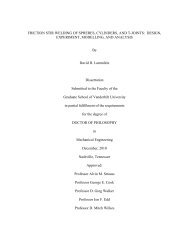Fite, Shao, and Goldfarb.pdf - Vanderbilt University
Fite, Shao, and Goldfarb.pdf - Vanderbilt University
Fite, Shao, and Goldfarb.pdf - Vanderbilt University
You also want an ePaper? Increase the reach of your titles
YUMPU automatically turns print PDFs into web optimized ePapers that Google loves.
IEEE TRANSACTIONS ON ROBOTICS AND AUTOMATION, VOL. 20, NO. 3, JUNE 2004 621<br />
Fig. 2.<br />
Model of master/human dynamics.<br />
Fig. 3. Parsing the master/human dynamics. (a) Schematic of closed-loop<br />
force-controlled master manipulator interactingwith human. (b) Schematic of<br />
fully parsed voluntary <strong>and</strong> feedthrough effects.<br />
is essentially an exogenous input (i.e., not part of the feedback loop),<br />
is parsed from the teleoperator feedback loop. Consider, for example,<br />
a linear single-DOF master/human subsystem, which can be modeled<br />
as shown in Fig. 2 <strong>and</strong> described in [13]. In this model, the master<br />
manipulator is considered a simple mass-damper system (b m ;m m )<br />
that is kinematically coupled to the human arm. The arm is modeled as<br />
a mass-spring-damper system (m h ;b 2;k 2) with an additional stiffness<br />
<strong>and</strong> damping (b 1 ;k 1 ) at the human/master interface (i.e., compliance<br />
in the human grip). Human voluntary input x hv is comm<strong>and</strong>ed directly<br />
into the base of the arm mass-spring-damper system, <strong>and</strong> is therefore<br />
filtered by these dynamics before resultingin motion of the master<br />
manipulator, a notion that is consistent with prior studies in human<br />
motor control [14]. The iconic model clearly indicates that slave<br />
motion comm<strong>and</strong> x h can result from either the voluntary human input<br />
x hv or the feedthrough force F h . In order to express the teleoperator<br />
system in terms of a classical loop with the human voluntary input<br />
as an exogenous comm<strong>and</strong>, the multiple-input single-output (MISO)<br />
human arm system depicted in Fig. 2 must be restructured as follows.<br />
Assumingthat the master closed-loop force controller is described by<br />
the transfer function C m , the master/human dynamics can be written<br />
in the block diagram form shown in Fig. 3(a), where G 1; G 2, <strong>and</strong> G 3<br />
are transfer function matrices given by<br />
where<br />
A =<br />
G 1 = 0<br />
G 2 = 0 0 0<br />
b 2 s + k 2<br />
m m<br />
0 0<br />
C m<br />
m m<br />
T<br />
T<br />
(1)<br />
(2)<br />
G 3 = C(sI 0 A) 01 (3)<br />
0 1 0 0<br />
0(k +k ) 0(b +b ) k b<br />
m<br />
m m m<br />
0 0 0 1<br />
k<br />
b 0k 0(b +b )<br />
m<br />
m m m<br />
C =[0k 1 0b 1 k 1 b 1] (5)<br />
(4)<br />
Fig. 4. Slave/environment dynamics. (a) Schematic of closed-loop<br />
motion-controlled slave manipulator interactingwith environment impedance.<br />
(b) Restructuringof interaction, indicatingdependence of G on Z . (c) Use<br />
of local feedback of environment interaction force to decouple G from Z .<br />
(d) Schematic of resultingdecoupled dynamics.<br />
<strong>and</strong> where Y h is the admittance of the human operator, given by<br />
Y h = sX h<br />
F h<br />
[m h s 2 +(b 2 + b 1)s +(k 2 + k 1)]s<br />
=<br />
: (6)<br />
m h b 1s 3 +(m h k 1 + b 1b 2)s 2 +(k 1b 2 + k 2b 1)s + k 1k 2<br />
All parameters in (1)–(6) are as defined in Fig. 2. The block diagram<br />
of Fig. 3(a) can be rearranged until the respective paths of the<br />
human voluntary input X hv <strong>and</strong> the feedthrough force F h contributing<br />
to the comm<strong>and</strong> motion X h are separated completely, as shown in<br />
Fig. 3(b). Specifically, the transfer function describing the force component<br />
actingon the human admittance resultingfrom human voluntary<br />
input is given by G hv , <strong>and</strong> the transfer function describingthe<br />
force component actingon the human admittance resultingfrom the<br />
feedthrough force is given by G m. Both transfer functions can be computed<br />
from (1)–(5) <strong>and</strong> from the expressions given in Fig. 3.<br />
The slave/environment dynamics depicted in Fig. 1 can be<br />
represented by the equivalent schematics of Fig. 4(a) <strong>and</strong> (b),<br />
both of which clearly indicate the dynamic couplingbetween the<br />
slave <strong>and</strong> environment. In the figures, Z e;Y s, <strong>and</strong> C s represent<br />
the environment impedance, slave manipulator admittance, <strong>and</strong><br />
position controller, respectively, <strong>and</strong> G ~ s represents the closed-loop<br />
single-input, single-output (SISO) slave transfer function, which is<br />
clearly a function of the environment impedance. Reconfiguring the<br />
human-manipulators-environment system into a classical feedback<br />
loop, as described by Figs. 3(b) <strong>and</strong> 4(b), enables application of<br />
classical control techniques to address the transparency <strong>and</strong> stability<br />
of the system, as initially described in [12]. The proposed control<br />
approach incorporates two modifications to the two-channel bilateral

















